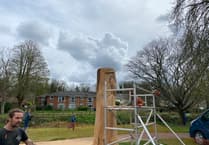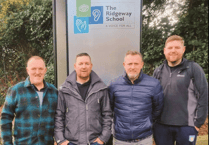MALINKA VAN DER GAAUW takes a walk along the route of the former Rother Valley Railway and discovers its importance to rural communities.
The Downs are an imposing natural barrier to the south of our area, so it is no surprise that for centuries local people preferred to travel and trade along the flat, sandy soils of the Rother, between Petersfield and Pulborough rather than up and over the steep, scarp slope.
If you know where to look, the history of this vital communications corridor is still visible today, providing a vivid picture of centuries gone by. There are the pubs that were once coaching inns; the remains of toll houses and turnpike gates, constructed to gather revenue; a plaque on a river bridge warning drivers of steam engines against seeking water; as well as the many bridges and cuttings of the former railway that once ran through the valley.
Between Petersfield and Midhurst there is only one section of public footpath along the former track bed of the Rother Valley Railway, but there are several places where paths cross it.
Despite having walked these routes many times, on each occasion I find myself wondering what could have been. You need look only as far as the Meon Valley Trail or Centurion Way between Midhurst and Chichester to see what a wonderful active travel and leisure facility former railway lines can provide.
Back in the 1960s a local paper headline read Branch Rail Line To Be Torn Up – No future plans, says Railway Authority, but open to bright ideas. Clearly everyone was out of bright ideas back then.
Disappointed by what could have been, I have instead been busying myself of late researching what was. I have discovered the Rother Valley Railway was described as “among the most beautiful lines in England”. Opening in 1864, this beauty, however, didn’t prove a big-enough pull and the line was eventually closed to passengers in the 1950s, long before Beeching’s axe fell a decade later.
Leading up to the war, the line appears to have been quite well used and even profitable, but it unfortunately never recovered from the arrival of buses and lorries afterwards.
Paradoxically, in the weeks leading up to the line’s closure to passengers in 1955, thousands of people turned up to ride the 9¼-mile journey. Perhaps you were one of them.
Petersfield resident Gordon Churchill has vivid memories of these last days, as his father was a signalman at the station. It appears it was an almost party-like atmosphere along the line with everyone desperate to have a ride, and well-wishers waving as the trains went by. Knowing many of the engine drivers through his father, Gordon was lucky enough to get rides on the engine footplate.
Listening to stories about the railway from different local people, it seems our town and local area might have been quite different without the Rother Valley Railway.
On the line, Nyewood station was known as ‘Rogate for South Harting’ as the tiny hamlet barely existed on the map. The reason we know of Nyewood today is largely because of an old brickworks.
This existed long before the arrival of the railway, but it had been losing money. In the late 1800s a new owner saw the opportunity the railway provided to turn the business around. He moved the yard alongside the line, where it had its own siding, and installed more modern facilities.
By the early 1900s the works was producing 100,000 bricks a day, employed 60 men, had acquired an international reputation and given rise to two pubs in the village. If only we could find similar stimuli for economic growth – read ‘to keep pubs going’ – in our rural communities today.
At first glance it would seem the railway had little effect on farming communities, simply steaming on past, but there you would be wrong. Not only did it provide jobs for lengthsmen, who were as vital then as today’s countryside rangers when it came to managing the flora and fauna along the line, but the railway was also the ‘common carrier’.
This meant it was obliged to transport anything and everything. This included whole farms. The mind boggles at this concept today, but believe it or not, some of our local farming families moved to this area from further afield by putting their livestock on the train and then driving the animals the final few miles from the station.
Gordon also remembers seeing wagons full of antlers in the Petersfield goods yard, possibly from the annual cull at Petworth. One other big plus of the railway was that it transported polo ponies across to Cowdray. Just imagine, no enormous horse lorries navigating the bends and narrow bridge around Trotton. It’s almost worth turning back the clock for that.
One of the most endearing tales I heard about the Rother Valley Way was its contribution to local weather forecasting.
It was said that if you were in Elsted and heard the whistle on steam trains at Buriton tunnel on the main line, rain was imminent, but hearing the whistle on branch line trains was a harbinger of the weather set fair.
At first I thought this an apocryphal tale, but when you consider the role wind plays in carrying sound, it could be as accurate a forecaster of the weather as any of the tech we use today.
Perhaps when recruiting our new town crier their audition should include whistle blowing from various parts of the town, so they are able to provide an up-to-date weather forecast along with the town news!




